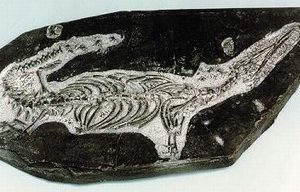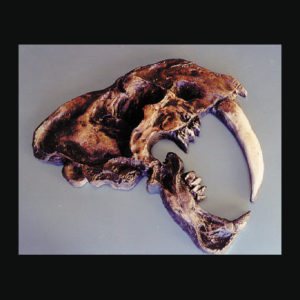All items sold on this website are polyurethane resin replicas, made in USA. No real or natural bone is available on this site.
-
Mesosaur Skeleton Plaque
$65.00A characteristic of Mesosaur was the length of the tail and the amount of caudal vertebrae. There were about 60-64 caudal vertebrae, which is very predictable for an aquatic predator…
-
Nanosaurus Rex Skull Profile
$20.00Nanosaurus or Nanosaurus agilis is known from material from all parts of the body, including two good skeletons, although the skull is still poorly known. It was a small animal,…
-
Nanosaurus Skeleton in Situ
$328.00Like several other neornithischian dinosaurs, such as Hypsilophodon, Thescelosaurus, and Talenkauen, Nanosaurus or Nanosaurus agilis had thin plates lying along the ribs. Called intercostal plates, these structures were cartilaginous in…
-
Nyctosaurus Skeleton Panel
$524.00The jaws of Nyctosaurus or Nyctosaurus gracilis were long and extremely pointed. The jaw tips were thin and needle sharp, and are often broken off in fossil specimens, giving the…
-
Oreodont Skeleton Situ Plaque
$429.00The Oreodont or Merycoidodon culbertsoni was a diverse group of stocky prehistoric mammals that grazed amid the grasslands, prairies, or savannas of North and Central America throughout much of the…
-
Parasaurolophus Dinosaur Skull Plaque
$1,500.00Parasaurolophus was a long-crested, duck-billed dinosaur. Parasaurolophus grew to be about 40 feet (12 m) long and 8 feet (2.8 m) tall at the hips. It weighed about 2 tons….
-
Psittacosaurus Dinosaur Skeleton
$365.00The bony core of the Hongshanosaurus beak may have been sheathed in keratin to provide a sharp cutting surface for cropping plant material. As the generic name suggests, the short…
-
Pterodactylus Kochi Skeleton Plaque
$54.00Fossil remains of Pterodactylus or Ornithocephalus antiquus have primarily been found in the Solnhofen limestone of Bavaria, Germany, which dates back to the Late Jurassic period (early Tithonian stage), about…
-
Rhamphorhynchus Skull Plaque
$20.00Adult Rhamphorhynchus also developed a strong upward “hook” at the end of the lower jaw. The number of teeth remained constant from juvenile to adult, though the teeth became relatively…
-
Ripeosaurian Complete Skeleton Plaque
$197.00Emeroleter levis was a small, carnivorous, and at times insectivorous parareptilian (early extinct reptile) dating from the Middle to Late Permian period.
-
Sabertooth Cat Skull Plaque
$36.00Sabertooth Cat or Smilodon fatalis died out at the same time that most North and South American megafauna disappeared, about 10,000 years ago. Its reliance on large animals has been…
-
Tropenognathus Pterosaurs Skull Plaque
$150.00The skull of Tropeognathus pterosaur bore distinctive convex “keeled” crests on its snout and underside of the lower jaws, and this was prominent, well-developed, and relatively large in Tropeognathus, specially…
-
Tyrannosaurus Rex Skull Plaque
$28.00The largest known Tyrannosaurus rex skull is 5 ft. in length. Large openings in the skull reduced weight. Tyrannosaurus’s skull was significantly different from those of large non-tyrannosaurid theropods. It…
-
Velociraptor osmolskae Skeleton Plaque
$1,750.00Velociraptor mongoliensis, like other dromaeosaurids, had a large manus (‘hand’) with three strongly curved claws, which were similar in construction and flexibility to the wing bones of modern birds. The…















